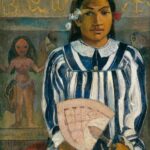When Paul Gauguin traveled to Tahiti in 1891, he was searching for an escape from the industrialized world and the constraints of European society. Little did he know that this journey would introduce him to Teha’amana, a young Tahitian girl who would become both his muse and a central figure in his artwork. This article delves into the complex and controversial relationship between Gauguin and Teha’amana, exploring how it influenced his art and legacy.
Gauguin’s European Discontent
Paul Gauguin, a Post-Impressionist painter, was disillusioned with the modernity and materialism of late 19th-century Europe. He longed for a more primitive, unspoiled environment where he could find inspiration for his art. Europe, with its rapid industrialization and changing social norms, seemed suffocating to him. He desired a return to simplicity and authenticity, which he believed could be found in the exotic islands of the South Pacific.
Gauguin’s dissatisfaction was not only with society but also with his personal life. He had previously worked as a stockbroker, a career that left him unfulfilled. Despite moderate success as an artist, he felt his work lacked the raw, emotional depth he craved. This inner turmoil pushed him to seek a drastic change, leading him to Tahiti, where he hoped to rediscover his artistic voice.
In letters to his friends, Gauguin expressed his yearning for a different life. He wrote, “I am leaving to escape civilization. I want to rest and forget everything about it.” This desire to disconnect from the complexities of modern life was a driving force behind his journey. Tahiti represented a fresh start, a blank canvas where he could redefine himself both as a man and as an artist.
Arrival in Tahiti
Gauguin arrived in Tahiti with high hopes in June 1891. The lush landscapes, vibrant colors, and distinct culture fascinated him. He wanted to immerse himself in a society that he perceived as untainted by Western influence. However, he soon realized that Tahiti was not entirely the untouched paradise he had imagined. French colonialism had already made its mark on the island, altering many aspects of traditional Tahitian life.
Despite his initial disappointment, Gauguin was determined to find inspiration. He moved to the village of Mataiea, where he built a bamboo hut and began to live among the locals. His aim was to absorb the culture and traditions of the Tahitian people, which he hoped would reflect in his art. Gauguin’s quest for artistic rejuvenation was just beginning, and it was in Mataiea that he met Teha’amana.
Teha’amana, known as Tehura in some accounts, was a young Tahitian girl who became Gauguin’s companion and muse. She was around 13 years old when they met, and their relationship quickly became both personal and professional. Teha’amana’s presence in Gauguin’s life provided the exotic allure he had been searching for, and she became a central figure in many of his works.
Gauguin’s relationship with Teha’amana was complex. To him, she symbolized the pure, unspoiled beauty of Tahiti. However, their relationship was also marked by the power imbalance typical of colonial relationships. Gauguin’s portrayal of Teha’amana in his art often reflected his romanticized and sometimes exploitative view of Tahitian culture.
Teha’amana: The Muse
Teha’amana played a crucial role in Gauguin’s artistic journey. Her image appears in many of his paintings, often symbolizing the connection between the spiritual and earthly realms. In works like “Spirit of the Dead Watching,” Teha’amana is depicted in a dreamlike, almost mystical manner. This painting, created in 1892, shows her lying on a bed, with a ghostly figure in the background, reflecting Gauguin’s fascination with Tahitian spirituality and mythology.
The painting “Spirit of the Dead Watching” is one of Gauguin’s most famous works featuring Teha’amana. The dark, moody colors and the tense expression on Teha’amana’s face convey a sense of fear and mystery. Gauguin claimed that the painting was inspired by an actual event when Teha’amana was frightened by a spirit. This blend of reality and mythology is a recurring theme in Gauguin’s Tahitian works.
In addition to “Spirit of the Dead Watching,” Teha’amana appears in other notable works such as “The Ancestors of Tehamana” and “Tehamana Has Many Parents.” These paintings depict her in traditional Tahitian dress, surrounded by symbols of Tahitian culture. Through these works, Gauguin aimed to capture the essence of Tahitian life, filtered through his unique artistic vision.
Gauguin’s portrayal of Teha’amana was not merely an artistic choice but also a personal one. Their relationship influenced his perception of Tahitian culture and spirituality, which in turn shaped his art. By painting Teha’amana, Gauguin sought to bridge the gap between his European background and the Tahitian world he had come to embrace.
Cultural Misunderstandings
Despite Gauguin’s deep fascination with Tahitian culture, his understanding of it was often flawed and superficial. He approached Tahiti with a romanticized view, seeing it as an untouched paradise. This perspective led to numerous cultural misunderstandings, which were evident in both his personal life and his artwork.
Gauguin’s depiction of Tahitian life was frequently filtered through his European lens. He idealized the simplicity and perceived innocence of the Tahitian people, often ignoring the complexities and hardships they faced. This romanticized view was a common trait among many European artists and writers of the time, who saw the “exotic” as a means to escape the pressures of modern life.
One significant cultural misunderstanding was Gauguin’s interpretation of Tahitian spirituality. While he was fascinated by Tahitian myths and legends, his depictions were often more reflective of his imagination than of actual Tahitian beliefs. This is evident in paintings like “Mahana No Atua” (Day of the God), where Gauguin portrays a mix of Christian and Tahitian symbols, creating a hybrid mythology that was more about his own spiritual journey than an accurate representation of Tahitian religion.
Gauguin’s relationship with Teha’amana also highlighted the cultural divide. While he viewed their relationship through a romantic and artistic lens, it was also shaped by colonial power dynamics. Teha’amana, as a young Tahitian girl, had limited agency in their relationship. This imbalance was a reflection of the broader colonial context, where European settlers often exploited local populations.
The Impact on Gauguin’s Art
The influence of Teha’amana and Tahiti on Gauguin’s art was profound. His time in Tahiti marked a significant shift in his artistic style, characterized by bold colors, simplified forms, and a focus on symbolism. This period produced some of his most iconic works, which are celebrated for their unique blend of European and Polynesian elements.
Gauguin’s use of color became more experimental during his Tahitian period. He employed vibrant, unconventional hues to evoke the lush landscapes and rich cultural tapestry of Tahiti. This bold use of color was a departure from the more subdued tones of his earlier work and became a defining feature of his style. Paintings like “Where Do We Come From? What Are We? Where Are We Going?” exemplify this vibrant palette.
Symbolism also played a crucial role in Gauguin’s Tahitian works. He often incorporated Tahitian motifs and mythological elements into his paintings, creating a layered narrative that combined his own beliefs with those he encountered in Tahiti. This symbolic approach allowed Gauguin to explore themes of life, death, and spirituality in a deeply personal way.
Teha’amana’s presence in Gauguin’s art served as a conduit for these symbolic explorations. Her depiction in his paintings often conveyed a sense of mystery and otherworldliness, reflecting Gauguin’s fascination with the spiritual aspects of Tahitian culture. By using Teha’amana as a muse, Gauguin was able to merge his artistic vision with his experiences in Tahiti, creating a body of work that is both unique and evocative.
Legacy and Controversy
Gauguin’s relationship with Teha’amana and his time in Tahiti have been the subject of much debate and controversy. While his Tahitian works are celebrated for their artistic innovation, they are also criticized for their exploitative nature and cultural appropriation. Gauguin’s portrayal of Tahiti and its people has been scrutinized for its romanticization and inaccuracies.
The age difference between Gauguin and Teha’amana is one of the most contentious aspects of their relationship. Gauguin was in his 40s when he met the young Teha’amana, a dynamic that has been criticized for its exploitative nature. This aspect of their relationship is often viewed through a modern lens, raising questions about power, consent, and colonial exploitation.
Despite these controversies, Gauguin’s time in Tahiti had a lasting impact on the art world. His bold use of color, innovative compositions, and incorporation of non-Western elements influenced many artists who came after him. Gauguin’s Tahitian works are considered masterpieces of Post-Impressionism, and they continue to be studied and admired for their artistic merit.
Gauguin’s legacy is thus a complex one, marked by both artistic brilliance and ethical questions. His relationship with Teha’amana exemplifies this complexity, highlighting the interplay between personal experience and artistic creation. As art historian Nancy Mowll Mathews wrote, “Gauguin’s life and work continue to provoke and inspire, challenging us to consider the boundaries between admiration and appropriation, between influence and exploitation.”
Conclusion
Paul Gauguin’s journey to Tahiti and his relationship with Teha’amana remain subjects of fascination and debate. Teha’amana’s role as his muse was integral to his artistic transformation, providing inspiration that fueled some of his most iconic works. However, their relationship also underscores the complexities and ethical dilemmas of cross-cultural interactions during the colonial era.
Gauguin’s art, influenced by his experiences in Tahiti, continues to captivate audiences with its bold colors, symbolic depth, and unique blend of cultural elements. Yet, it also serves as a reminder of the power dynamics and cultural misunderstandings that shaped his work. Teha’amana, as both a muse and a symbol, reflects the duality of Gauguin’s legacy—one of artistic innovation and controversial exploitation.
In exploring the story of Gauguin and Teha’amana, we are reminded of the intricate connections between art, culture, and history. Their relationship invites us to look beyond the surface of Gauguin’s vibrant paintings and consider the deeper narratives they represent. Through this lens, we can appreciate the beauty and complexity of Gauguin’s work while acknowledging the ethical questions it raises.




